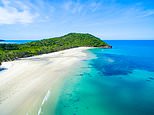
You may be surprised to learn that the world’s oldest tropical lowland rainforest – which dates back about 180 million years to the Jurassic era – is in Australia.
Queensland’s Daintree Rainforest, described by Sir David Attenborough as the most extraordinary place on Earth, measures just 463 square miles yet it packs in more tree species in one hectare than in the entire 210,000 square miles of the UK.
An astonishing 430 bird species, including the giant cassowary, call it home, 13 of which are found nowhere else on the planet. Its biggest tree is as tall as the Statue of Liberty, and there are 12,000 insect species as well as crocodiles and the reclusive Boyd’s forest dragon, a species of lizard.
Nature’s oasis: Claudia Joseph explores the sights of Queensland’s Daintree Rainforest, described by Sir David Attenborough as the most extraordinary place on Earth. Above is one of the spots she visits – Cape Tribulation, which is the only place in the world where two Unesco World Heritage sites meet: Daintree Rainforest and the Great Barrier Reef
As Sir David enthused: ‘It has, for the naturalist, everything. It is quite unlike any other rainforest in the world.’
Although not as famous as the Amazon, and tiny by comparison, visiting this unique region is an incredible experience.
My base is the Daintree Ecolodge, near Daintree Village in the heart of the rainforest, where you can drift into another realm thanks to its glorious landscape, enriching natural spa treatments and vibrant cuisine.
It is the only boutique accommodation in the rainforest, and its awe-inspiring setting will revitalise all your senses. With just 15 eco-friendly bayans – or treehouses – it would appeal to anyone who simply wants time to stand still.
Claudia checks into a bayan at the Daintree Ecolodge near Daintree Village in the heart of the rainforest. Pictured is the lodge’s Waterfall Deck
Inside one of the 15 eco-friendly bayans – or treehouses – at Daintree Ecolodge. The properties ‘appeal to anyone who simply wants time to stand still’
After a drive 90 miles north from Cairns Airport on Captain Cook Highway – one of Australia’s most spectacular coastal roads – I find the lodge on the bank of the Daintree River.
Set in the middle of the rainforest, it feels totally remote and is the perfect retreat from the stresses of life.
My bayan, nestled among the foliage in the breathtaking rainforest canopy, has floor-to-ceiling windows and a screened balcony to ensure you feel as close to nature as possible.
‘Set in the middle of the rainforest, it feels totally remote and is the perfect retreat from the stresses of life,’ Claudia says of the lodge
In fitting with its environment, the Daintree Ecolodge aims to reduce its carbon footprint with solar panels, a biocycle waste-water plant which recycles all its water, a herb and vegetable patch to provide a constant supply of fresh produce, and toxic-free cleaning products.
After dinner on the balcony of Julaymba Restaurant overlooking the lagoon – a melt-in-the-mouth spanner crab risotto with corn, chive and crustacean oil followed by a tender beef rump cap with celeriac, mushroom, onion, kale and black garlic – I stroll back to my bayan and drift off to sleep to the gentle sounds of the nearby waterfall.
The following morning I wake at the crack of dawn to the sound of curlews, and sit on the balcony watching this unique world go by, before making my way to breakfast at Julaymba. I plump for a spinach, chorizo, pepper, onion and parmesan omelette.
The Daintree Ecolodge, which aims to reduce its carbon footprint, has a herb and vegetable patch to provide a constant supply of fresh produce
Above is the lodge’s Julaymba restaurant, where Claudia tucks into a melt-in-the-mouth spanner crab risotto with corn, chive and crustacean oil for dinner
During her stay at the lodge, Claudia wakes ‘at the crack of dawn to the sound of curlews’
Guests can then enjoy a leisurely stroll to the waterfall, take a dip in the pool or visit the health spa.
There is a wealth of places to visit in the rainforest, including Mossman Gorge, the Daintree River and Cape Tribulation. The one-day Daintree Discovery Tour showcases the highlights, beginning with a visit to the Mossman Gorge Visitors Centre.
As I walk in, I spot a number of golden orb spiders spinning their webs. ‘She has a lovely role in life,’ says tour guide Mel Micallef. ‘She mates and then she eats her mate. She’s really cool.’
It becomes something of a theme: the female cassowary mates and lays her eggs before abandoning them for another partner, leaving her original partner to look after the offspring. ‘It’s something of a matriarchal society,’ Mel jokes.
To reach the rainforest, Claudia drives north from Cairns Airport on Captain Cook Highway – one of Australia’s most spectacular coastal roads. Above is the view from the Rex Lookout along the highway
The tour begins with a traditional smoking ceremony by a guide from the Kuku Yalanji tribe to ward off bad spirits. He demonstrates how he paints his body with a Totem, or ‘personal guardian angel’, which signals his tribe to other indigenous Australians.
The different paints, he says, have alternative benefits – the clay contains calcium for bone density; the black charcoal is an alternative to toothpaste; and the zinc doubles as suntan lotion and is good for treating mosquito bites.
We then head into Mossman Gorge along a wooden boardwalk, among birds’ nests and basket ferns. ‘You feel like George of the Jungle up here,’ laughs Mel. ‘The ferns are like the apartment blocks of the rainforest. They’re fighting to take over – they climb their way to the top to get light.’
On a one-day Daintree Discovery Tour, Claudia embarks on a ‘mesmerising’ boat trip up the mighty Daintree River
We also spot balanophora fungosa, the world’s only flowering mushrooms, and cassowary plums, which look like blue avocados and, unless you are one of the giant birds, are toxic. ‘If you get the juice in your eye, it will blind you,’ adds Mel.
After tea and dampers (giant scones dotted with wattleseed), we wind our way along Captain Cook Highway, past fields of sugar cane and banana plantations, up to the mighty Daintree River. The landscape is mesmerising and seems to go on for ever, with giant mountains and lush green valleys in the distance.
We pass through the township of Mossman, which has the most northern mill in Australia, built in 1904 to convert sugar cane to raw sugar, and spot trains trundling along the tracks from field to mill, laden with canes.
We then pass a saltwater barramundi farm – the fish, which can reach 6ft and weigh 130 lb, is a delicacy in these parts – before crossing the Daintree River aboard its traditional wooden ferry, with white herons swarming over us.
The tour takes Claudia into the Mossman Gorge (pictured) along a wooden boardwalk, among birds’ nests and basket ferns
Claudia enjoys lunch at On The Turps, an open-air restaurant where they serve barramundi or steak and chips, Thai curry and fettucini
The second walk of the day took us along the Jindalba Boardwalk, where we find sheoak trees, which are used by indigenous Australians who carve boomerangs out of the overground roots.
After lunch at On The Turps, an open-air restaurant in the Heritage Lodge where they serve barramundi or steak and chips, Thai curry and fettucini, there is time for a refreshing swim in Cooper Creek.
The next highlight is the drive from Cooper Creek to Cape Tribulation, where we kept our eyes peeled for cassowary, the third-tallest and second-heaviest bird in the world, as well as the most lethal: it has often been labelled the world’s most dangerous bird as its giant claws do a lot of damage to humans if you upset them.
‘If you come across a cassowary in the wild, put your backpack in front of you and back away slowly,’ warns Mel.
Lush: You can spy sheoak trees, which are used by indigenous Australians who carve boomerangs out of the overground roots, on the Jindalba Boardwalk (pictured)
Claudia goes for a refreshing swim in Cooper Creek, pictured, before her tour takes her to Cape Tribulation
An astonishing 430 bird species, including the giant cassowary (left) – which has ‘often been labelled the world’s most dangerous bird’ – call the rainforest home. Claudia’s guide tells her: ‘If you come across a cassowary in the wild, put your backpack in front of you and back away slowly.’ The reclusive Boyd’s forest dragon, a species of lizard (right), can also be spotted in the rainforest
TRAVEL FACTS
Claudia Joseph was a guest of Northern Escape Collection. A lagoon bayan at Daintree Ecolodge costs from A$475 a night for two, including breakfast. The full-day Daintree Discovery Tour costs A$224 per adult and A$204 per child aged ten to 14 (daintreediscoverytours.com.au).
Luckily, we are in a sturdy four-wheel-drive vehicle when we spot a trio of birds – a male and two babies – on our way to Cape Tribulation.
But it is on our way back that we encounter a rarity: a pair of cassowaries with their offspring.
Even a group of motorcyclists, held up by them crossing the road, stop to take photographs.
You don’t often see a couple together, as the female is usually long gone, according to Mel.
Cape Tribulation itself is an extraordinary botanical treasure – the only place in the world where two Unesco World Heritage sites meet: Daintree Rainforest and the Great Barrier Reef.
I make my way on to the horseshoe-shaped coastline, which is lined with mangrove trees, and it is incredible to experience the juxtaposition of tropical rainforest and coral reef.
Finally we take a cruise in a flat-bottomed boat along Daintree River, searching for saltwater crocodiles – known as salties – the largest of all reptiles.
Claudia spots a 10ft-long adult female crocodile basking in the sunshine on the banks of the Daintree River (pictured)
Claudia watches as Thornton Peak, Queensland’s third-highest mountain, disappears into the clouds. Above is the view from the top of the peak, image courtesy of Creative Commons
And within minutes we spot a young crocodile spreadeagled on a beach at the side of the river.
But then, as we watch Thornton Peak, Queensland’s third-highest mountain, disappear into the clouds, we spy the piece de resistance: a 10ft-long adult female basking in the sunshine on the riverbank.
I’m sure that even Sir David Attenborough would have been impressed.
AUSTRALIA BOOMS FOR GOLDEN GAP YEAR TRAVELLERS
It’s known as the ‘Golden Gap Year’ – an extended holiday for those who are retired or who want to take a sabbatical out of daily life – and Australia is proving a popular destination for it.
According to research from Norwegian Cruise Line (NCL), four out of ten Baby Boomers are planning trips of about nine months, with 38 per cent fancying some time in Australia. Horseback-riding through the rainforest and scuba-diving at the Great Barrier Reef are among the things they would most like to experience.
For those who do not want to book an organised tour, a fly-drive or rail experience cruise is proving a popular option – with half of those surveyed saying that travel is a worthwhile use of their money, and 20 per cent saying they will take a cruise in the next two years.
NCL’s 12-day cruise on Norwegian Spirit from Auckland and taking in Melbourne and Sydney, from February 20 to March 4, 2023, costs from £3,303pp.
A similar 12-day cruise in January 2024 goes the other way, starting in Sydney and including an overnight stop in Melbourne and time in Auckland to take advantage of its beautiful beaches and coastal trails.
More details at ncl.com.
Source link
CHECK OUT: Top Travel Destinations
READ MORE: Travel News



